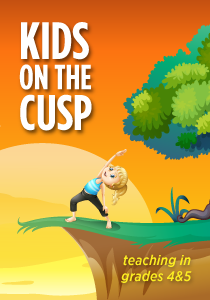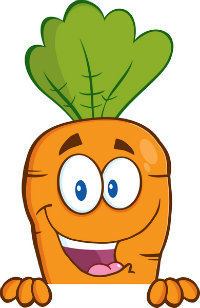Kids Need Some Carrots to Inspire Learning
A MiddleWeb Blog

Our favorite kind of carrots these days are what we call “sweet carrots.” I made them up one night when I hadn’t been able to stop by the grocery store after school, and was scrambling to cook a somewhat healthy dinner. The cupboard was more than a little bare, and I found myself foraging in the fridge, grasping at…well…carrots.
A little parboiling, some butter, and a large spoonful of brown sugar was all it took. There was no need to convince my kids to eat the carrots. Okay, I did officially name them “sweet carrots” when I served them that first time, but only as a precautionary measure.
If only life were as simple as sweet carrots.
The Carrot or Stick Culture

The old idiom, “carrot on a stick” or “carrot and stick,” uses this simple root vegetable to illustrate two very different ways of motivating people. The carrot “on” the stick is a tool to dangle in front of a beast of burden to get it to move or pull a heavy load. Carrot “or” the stick, implies using either positive reinforcement, the enticing carrot, or negative consequences, namely a beating with a stick!
Jan Freeman, a columnist for boston.com, explores the history behind these ideas in her article, “Carrot Unstuck.” Freeman gives evidence to enlighten us on the history of the carrot idiom, and concludes that, “The carrot and the stick can be many things.”
She also reminds us that, “The carrot ruse is not presented (historically) in a way we often take it today, as a manipulative trick. On the contrary, the carrot is meant to be the kind, enlightened alternative to the stick.”
Carrots to Discover Motivation

Carrots are an excellent source of beta carotene, and Writers Notebooks are an excellent source of getting to the root of the matter, to find out what motivates each individual learner.

A 4th grader’s list of things to be thankful for
Our recent, three-week journaling assignment asked each student to choose from five possible responses and to submit a total of seven detailed and well-written journal entries.
The prompts themselves were designed to make the kids reflective of each day. Some asked the kids to consider what they do well and what they need to work on improving. Some simply gave them the opportunity to write about their lives and their daily routines inside and outside of school.
What they say about home gives me insight into the pressures they feel outside of school. What they say about our daily routines at school helps me make adjustments to my teaching and to personalize my instructional approaches. These things, along with small peeks into their hopes, fears, and dreams, help me identify any carrot that may need dangling.
Most students are easily motivated by sweet carrots. These are activities they naturally enjoy. Others prefer a different type of karat, represented by the riches and jewels that glitter in Homework Passes and Free Choice Activities. Still others choose the caret, which shows an innate desire to review their efforts, to look for extra credit opportunities, and to intrinsically insert changes that will enhance their learning experience.
Applying Lessons from the Business World
Adrian Gostick and Chester Elton, authors of The New York Times bestseller The Carrot Principle, have conducted long-term research that claims that carrots may, in fact, be the answer to some of the pressing issues facing big business, and therefore, Big Education.

Gostick and Elton’s basic principles focus on how recognizing the contributions of employees is “no longer the soft side of leadership, but a secret ingredient that great leaders add to their companies for direct and positive impact on profits.”
According to their research, which spanned over 10 years and 200,000 people, “Organizations that are effective at employee recognition are not only more profitable, but have people who are willing to go further, stay later, and take on more.”
In Chapter 7 of their book, Gostick and Elton remind us that, “Culture colors everything we do. Culture is how you do things: the rules, spoken or unspoken, that you play by. Culture is the foundation of everything you embrace, and the reason for everything you do.” Does this apply to classroom culture? I think so.
Recognizing Carrot Moments
When I think about Gostick and Elton’s idea of the benefits of recognition, I think about that old teacher trick of “catching kids being good” rather than focusing on negative behavior. Recognizing the efforts of each student affects the entire learning community.

In an article on the application of the Carrot Principle for school administrators, Christina Feneley discusses the importance of building trust. Just like administrators, teachers need to build trust with their students to be effective leaders. Feneley reminds us that, “Mistakes will always be made; holding your (students) accountable includes celebrating the mistakes that were worth being made in light of the innovation and progress that accompanied them.”
A teacher’s comment that “Johnny forgot his homework when he packed up yesterday, but he came in early this morning to take responsibility and get it done,” doesn’t let Johnny off the hook for forgetting his homework. It focuses on giving him recognition for being responsible and innovative in how he handled the situation. Simple statements like this have an impact on the classroom culture as a whole.
A Carrot (or Two) a Day
My job as an educator is to dangle learning opportunities in front of my students in the hopes of spurring enthusiasm, curiosity, and a desire to do their personal best. Intrinsic motivation, however, is not something that can be taught. By definition, it comes from within.
Kids need carrots, not to trick them, but to inspire them. Trying to get to the root of each individual learner, digging deeper in an effort to recognize each unique little person’s contributions to our classroom (and having a healthy sense of humor), help build our Carrot Community.
…That’s all, folks!


































